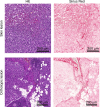Bimodal magnetic resonance and optical imaging of extracellular matrix remodelling by orthotopic ovarian tumours
- PMID: 32390007
- PMCID: PMC7374547
- DOI: 10.1038/s41416-020-0878-7
Bimodal magnetic resonance and optical imaging of extracellular matrix remodelling by orthotopic ovarian tumours
Abstract
Background: The extracellular matrix modulates the development of ovarian tumours. Currently, evaluation of the extracellular matrix in the ovary is limited to histological methods. Both magnetic resonance imaging (MRI) and two-photon microscopy (2PM) enable dynamic visualisation and quantification of fibrosis by endogenous contrast mechanisms: magnetisation transfer (MT) MRI and second-harmonic generation (SHG) 2PM, respectively.
Methods: Here, we applied the MT-MRI protocol for longitudinal imaging of the stroma in orthotopic human ovarian cancer ES-2 xenograft model in CD1 athymic nude mice, and for orthotopically implanted ovarian PDX using a MR-compatible imaging window chamber implanted into NSG mice.
Results: We observed differences between ECM deposition in ovarian and skin lesions, and heterogeneous collagen distribution in ES-2 lesions. An MR-compatible imaging window chamber enabled visual matching between T2 MRI maps of orthotopically implanted PDX grafts and anatomical images of their microenvironment acquired with a stereomicroscope and SHG-2PM intravital microscopy of the collagen. Bimodal MRI/2PM imaging allowed us to quantify the fibrosis within the same compartments, and demonstrated the consistent results across the modalities.
Conclusions: This work demonstrates a novel approach for measuring the stromal biomarkers in orthotopic ovarian tumours in mice, on both macroscopic and microscopic levels.
Conflict of interest statement
The authors declare no competing interests.
Figures






Similar articles
-
Stromal alterations in ovarian cancers via wavelength dependent Second Harmonic Generation microscopy and optical scattering.BMC Cancer. 2017 Feb 6;17(1):102. doi: 10.1186/s12885-017-3090-2. BMC Cancer. 2017. PMID: 28166758 Free PMC article.
-
Alterations of the extracellular matrix in ovarian cancer studied by Second Harmonic Generation imaging microscopy.BMC Cancer. 2010 Mar 11;10:94. doi: 10.1186/1471-2407-10-94. BMC Cancer. 2010. PMID: 20222963 Free PMC article.
-
A Novel Intravital Imaging Window for Longitudinal Microscopy of the Mouse Ovary.Sci Rep. 2015 Jul 24;5:12446. doi: 10.1038/srep12446. Sci Rep. 2015. PMID: 26207832 Free PMC article.
-
MR Imaging-Pathologic Correlation in Ovarian Cancer.Magn Reson Imaging Clin N Am. 2017 Aug;25(3):545-562. doi: 10.1016/j.mric.2017.03.004. Epub 2017 Apr 29. Magn Reson Imaging Clin N Am. 2017. PMID: 28668159 Review.
-
Ovarian solid tumors: MR imaging features with radiologic-pathologic correlation.Jpn J Radiol. 2020 Aug;38(8):719-730. doi: 10.1007/s11604-020-00976-8. Epub 2020 Apr 27. Jpn J Radiol. 2020. PMID: 32342277 Review.
Cited by
-
Highly Efficient Synergistic Chemotherapy and Magnetic Resonance Imaging for Targeted Ovarian Cancer Therapy Using Hyaluronic Acid-Coated Coordination Polymer Nanoparticles.Adv Sci (Weinh). 2024 Nov;11(41):e2309464. doi: 10.1002/advs.202309464. Epub 2024 Sep 17. Adv Sci (Weinh). 2024. PMID: 39287149 Free PMC article.
-
Therapeutic and diagnostic targeting of fibrosis in metabolic, proliferative and viral disorders.Adv Drug Deliv Rev. 2021 Aug;175:113831. doi: 10.1016/j.addr.2021.113831. Epub 2021 Jun 15. Adv Drug Deliv Rev. 2021. PMID: 34139255 Free PMC article. Review.
-
NIR-II Fluorescence Imaging for the Detection and Resection of Cancerous Foci and Lymph Nodes in Early-Stage Orthotopic and Advanced-Stage Metastatic Ovarian Cancer Models.ACS Appl Mater Interfaces. 2023 Jul 12;15(27):32226-32239. doi: 10.1021/acsami.3c04949. Epub 2023 Jun 29. ACS Appl Mater Interfaces. 2023. PMID: 37385963 Free PMC article.
-
Magnetization transfer imaging of ovarian cancer: initial experiences of correlation with tissue cellularity and changes following neoadjuvant chemotherapy.BJR Open. 2022 May 2;4(1):20210078. doi: 10.1259/bjro.20210078. eCollection 2022. BJR Open. 2022. PMID: 36105417 Free PMC article.
-
Prediction of Ovarian Follicular Dominance by MRI Phenotyping of Hormonally Induced Vascular Remodeling.Front Med (Lausanne). 2021 Aug 20;8:711810. doi: 10.3389/fmed.2021.711810. eCollection 2021. Front Med (Lausanne). 2021. PMID: 34490300 Free PMC article.
References
-
- Siegel RL, Miller KD, Jemal AJCacjfc. Cancer statistics, 2017. CA: Cancer J. Clin. 2017;67:7–30. - PubMed
-
- Davis A, Tinker AV, Friedlander MJGo. “Platinum resistant” ovarian cancer: what is it, who to treat and how to measure benefit? Gynecol. Oncol. 2014;133:624–631. - PubMed
-
- Helleman J, Jansen MP, Burger C, van der Burg ME, Berns EMJTijob, biology c. Integrated genomics of chemotherapy resistant ovarian cancer: a role for extracellular matrix, TGFbeta and regulating microRNAs. Int. J. Biochem. Cell Biol. 2010;42:25–30. - PubMed
-
- Zhang Y, Tang H, Cai J, Zhang T, Guo J, Feng D, et al. Ovarian cancer-associated fibroblasts contribute to epithelial ovarian carcinoma metastasis by promoting angiogenesis, lymphangiogenesis and tumor cell invasion. Cancer Lett. 2011;303:47–55. - PubMed
Publication types
MeSH terms
Substances
Grants and funding
- R01 CA075334/CA/NCI NIH HHS/United States
- 326/14/Israel Science Foundation (ISF)
- 232640-IMAGO/EC | EC Seventh Framework Programm | FP7 Ideas: European Research Council (FP7-IDEAS-ERC - Specific Programme: "Ideas" Implementing the Seventh Framework Programme of the European Community for Research, Technological Development and Demonstration Activities (2007 to 2013))
LinkOut - more resources
Full Text Sources
Medical

